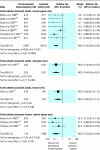Ultrasonic locating devices for central venous cannulation: meta-analysis
- PMID: 12919984
- PMCID: PMC175809
- DOI: 10.1136/bmj.327.7411.361
Ultrasonic locating devices for central venous cannulation: meta-analysis
Abstract
Objectives: To assess the evidence for the clinical effectiveness of ultrasound guided central venous cannulation.
Data sources: 15 electronic bibliographic databases, covering biomedical, science, social science, health economics, and grey literature.
Design: Systematic review and meta-analysis of randomised controlled trials. Populations Patients scheduled for central venous access. INTERVENTION REVIEWED: Guidance using real time two dimensional ultrasonography or Doppler needles and probes compared with the anatomical landmark method of cannulation.
Data extraction: Risk of failed catheter placement (primary outcome), risk of complications from placement, risk of failure on first attempt at placement, number of attempts to successful catheterisation, and time (seconds) to successful catheterisation.
Data synthesis: 18 trials (1646 participants) were identified. Compared with the landmark method, real time two dimensional ultrasound guidance for cannulating the internal jugular vein in adults was associated with a significantly lower failure rate both overall (relative risk 0.14, 95% confidence interval 0.06 to 0.33) and on the first attempt (0.59, 0.39 to 0.88). Limited evidence favoured two dimensional ultrasound guidance for subclavian vein and femoral vein procedures in adults (0.14, 0.04 to 0.57 and 0.29, 0.07 to 1.21, respectively). Three studies in infants confirmed a higher success rate with two dimensional ultrasonography for internal jugular procedures (0.15, 0.03 to 0.64). Doppler guided cannulation of the internal jugular vein in adults was more successful than the landmark method (0.39, 0.17 to 0.92), but the landmark method was more successful for subclavian vein procedures (1.48, 1.03 to 2.14). No significant difference was found between these techniques for cannulation of the internal jugular vein in infants. An indirect comparison of relative risks suggested that two dimensional ultrasonography would be more successful than Doppler guidance for subclavian vein procedures in adults (0.09, 0.02 to 0.38).
Conclusions: Evidence supports the use of two dimensional ultrasonography for central venous cannulation.
Figures
References
-
- Elliot TSJ, Faroqui MH, Armstrong RF, Hanson GC. Guidelines for good practice in central venous catheterization. J Hosp Infect 1994;28: 163-76. - PubMed
-
- Callum KG, Whimster F. Interventional vascular radiology and interventional neurovascular radiology: a report of the National Confidential Enquiry into Perioperative Deaths. Data collection period 1 Apr 1998 to 31 Mar 1999. London, NCEPOD, 2000.
-
- Trottier SJ, Veremakis C, O'Brien J, Auer AI. Femoral deep vein thrombosis associated with central venous catheterization: results from a prospective, randomized trial. Crit Care Med 1995;23: 52-9. - PubMed
-
- Calvert N, Hind D, McWilliams RG, Thomas SM, Beverley C, Davidson A. The effectiveness and cost-effectiveness of ultrasound locating devices for central venous access: a systematic review. Health Technol Assess 2003:7(12). - PubMed
-
- Schulz KF, Chalmers I, Hayes RJ, Altman DG. Empirical evidence of bias: dimensions of methodological quality associated with estimates of treatment effects in controlled trials. JAMA 2003;273: 408-12. - PubMed
Publication types
MeSH terms
LinkOut - more resources
Full Text Sources
Other Literature Sources
Medical


